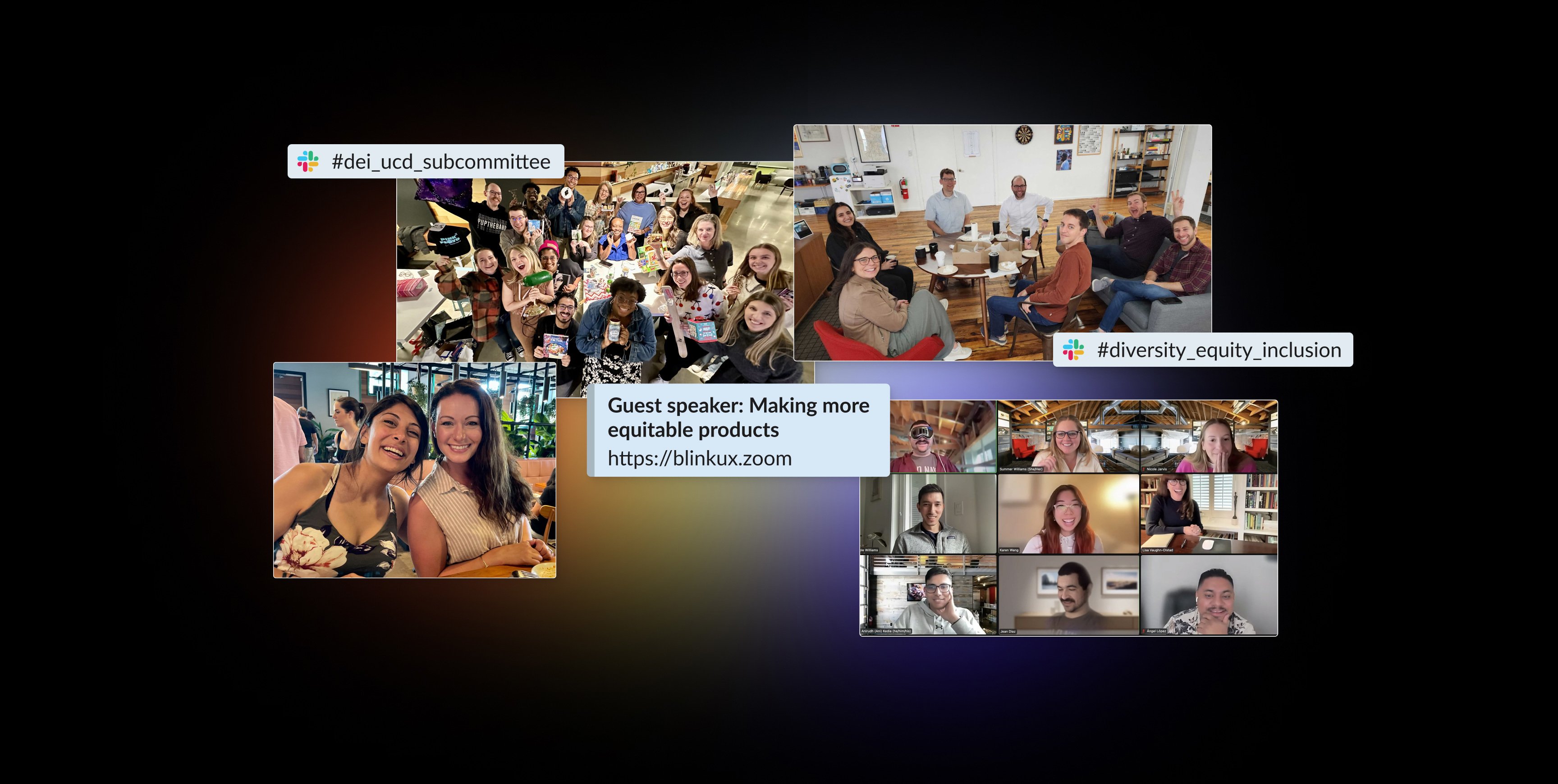
As consultants, our work is incredibly diverse — spanning industries, technologies, and a global user base. We know from experience that diverse teams solve diverse problems best, and inclusive work practices create more impactful products. Internally, we know that when employees feel a sense of inclusion and belonging, they are more engaged in their work, and they stay at the company longer, adding more value and helping build a positive culture.
In 2023, we continued our journey toward becoming a more diverse, inclusive, and equitable company. We know this work will never be complete, and it’s rarely easy. We make mistakes along the way. We remind ourselves to be humble and afford each other grace as we work through the ups and downs. We continue to feel grateful for our employees’ and clients’ openness to provide feedback so we can continue to improve.
Based on our annual internal cultural survey and company-wide demographic reporting in 2022, we determined four areas of improvement going into 2023:
- Continue to improve our user-centered design process
- Create more transparency around our internal pay, raise, and promotion process
- Launch a company-wide anti-harassment and unconscious bias training platform
- Launch the first DEI page on our website

How we improved our user-centered design process
Incorporating DEI in our design process is both a moral imperative and a strategic business advantage. We know accessible products relevant to a diverse audience have better customer engagement and loyalty. In 2023, we improved several phases of our user-centered design process to bring in more diverse perspectives and, as a result, build more inclusive products.
A new guide for stakeholder interviews: We updated our interview guide to include DEI questions and drive team alignment from the start. Our practice guidelines include asking our clients about their DEI goals. This allows us to bring relevant subject matter experts into the project early.
New guidelines for participatory design: By actively including users in the ideation of design concepts, participatory design works to address the root cause of problems rather than the symptoms. This method leads to more inclusive outcomes and can better address the unmet needs of historically underinvested and marginalized communities.
The new guidelines communicate the purpose and benefits as well as highlight example co-design activities, including concept cards, journey mapping, and empathy collaging. We were excited to employ participatory design in two projects in 2023 with both Google and Lumen Learning. In 2024 we hope to continue to incorporate this in more projects, including our pro bono program.
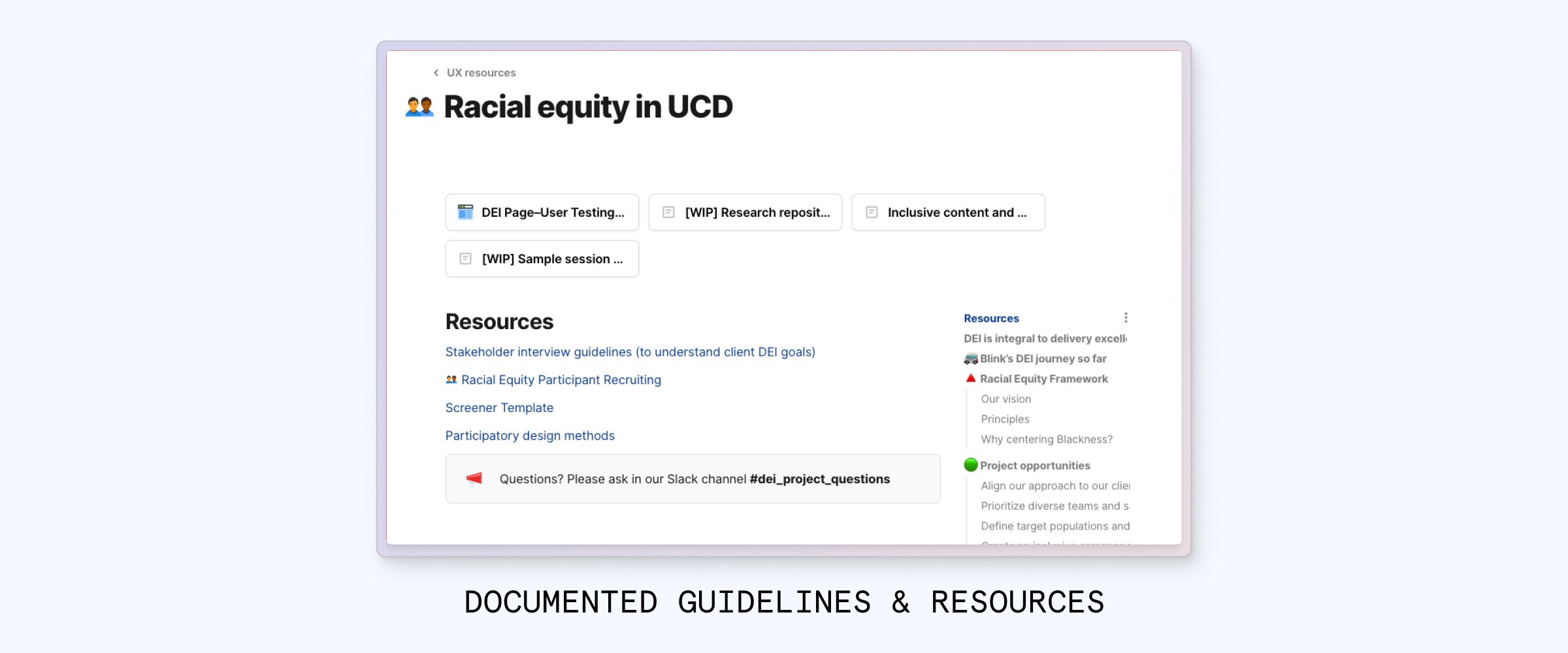
Updated requirements for participant recruiting: Our goal is to include people who have historically been excluded. By using probing client questions to understand user groups, clear quotas, and census data, we strive to ensure a variety of diverse voices in our research sessions.
Increased representation in our visual designs: We updated our visual design and content assets to have a more diverse representation of people from different races, genders, abilities, ages, and sexual orientations. We recommend our clients use these when developing any deliverables, whether the images are for screens within a product or slides in a presentation deck.
How we created more transparency around our internal pay, raise, and promotion process
When we measured the clarity and equity of our pay, raise, and promotion practices in a 2022 employee survey, the results were lower than average. These low scores signaled to leadership that we needed to examine our processes and see what we could improve.
We want our pay, raise, and promotion process to be transparent and built to allow all employees to be rewarded equitably. To improve this area of our business, we took a multilayered approach.

Established additional pay bands and clear team structures: We created clear levels of expertise and corresponding pay bands for teams at Blink where they were lacking. Levels and pay bands had existed for years for our design, research, and project management teams, but our smaller business operations teams needed this clarity. We spent several months designing a clear structure for our teams in HR, IT, marketing, and sales; this project helped us ensure all Blinkers are paid fairly compared to others with similar responsibilities.
Pay equity analysis: We examined salary data by level for gender, race, and ethnicity. Due to our small sample size, we collapsed categories. For gender, we used the legal status of male/female. Regarding race and ethnicity, we compared white employees to an aggregated group of all other employees. Our results showed no difference in pay between male/female and white/non-white employees. These results supported our belief that the structures and processes we had implemented to ensure pay equity were functioning as intended without hidden bias.
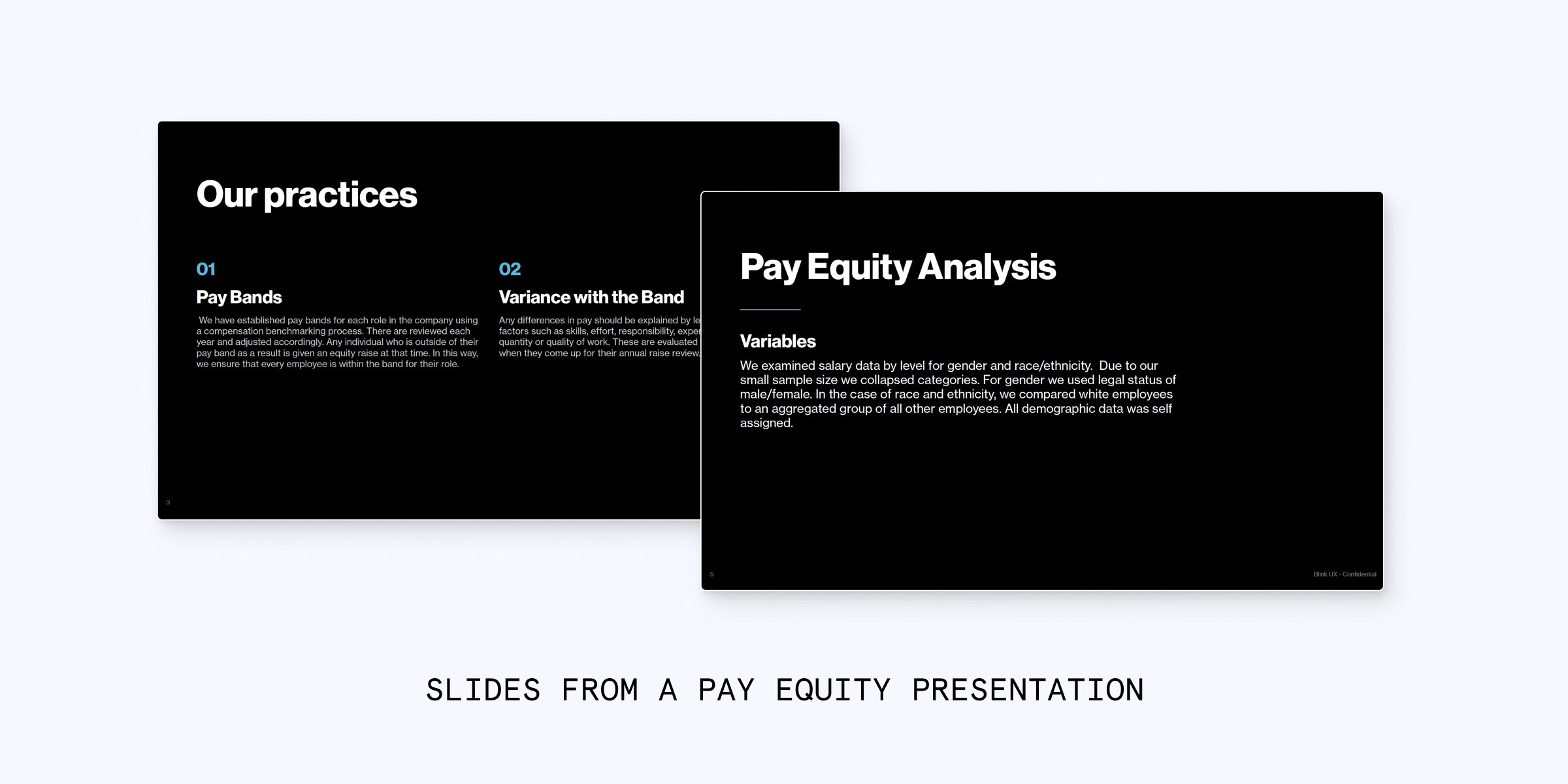
Clarity around pay and promotion process: A significant segment of our employee base indicated that they lacked clarity about how leaders were making decisions related to pay and promotions. We embarked on a mission to share this process with our employees, taking a total transparency approach. We shared when employees could expect a raise, the typical percent employees can expect to receive year-over-year, and our process for evaluating individuals for raises. We outlined and presented the information in several all-company meetings, added the information to our onboarding, and built a new section in our HR Wiki. We also spent time training our managers and directors about the processes in place.
When surveyed again at the end of the year, several employees continued to have questions and frustrations about this process. Feedback revealed that although we had improved clarity, we still needed to improve. In 2024, we’re taking a deeper look at how we can continue to improve our existing processes to increase inclusion around promotion decisions.
Launching a company-wide anti-harassment and unconscious bias training platform
As an employer in California, we are required to have employees undergo a state-approved sexual harassment training course every other year. We believe in the benefit of these trainings but have long wished that the educational tools available in the marketplace were more engaging and relevant. Often, the content is delivered in a way that causes managers to tune out or click through as quickly as possible, eliminating any intended positive impact.
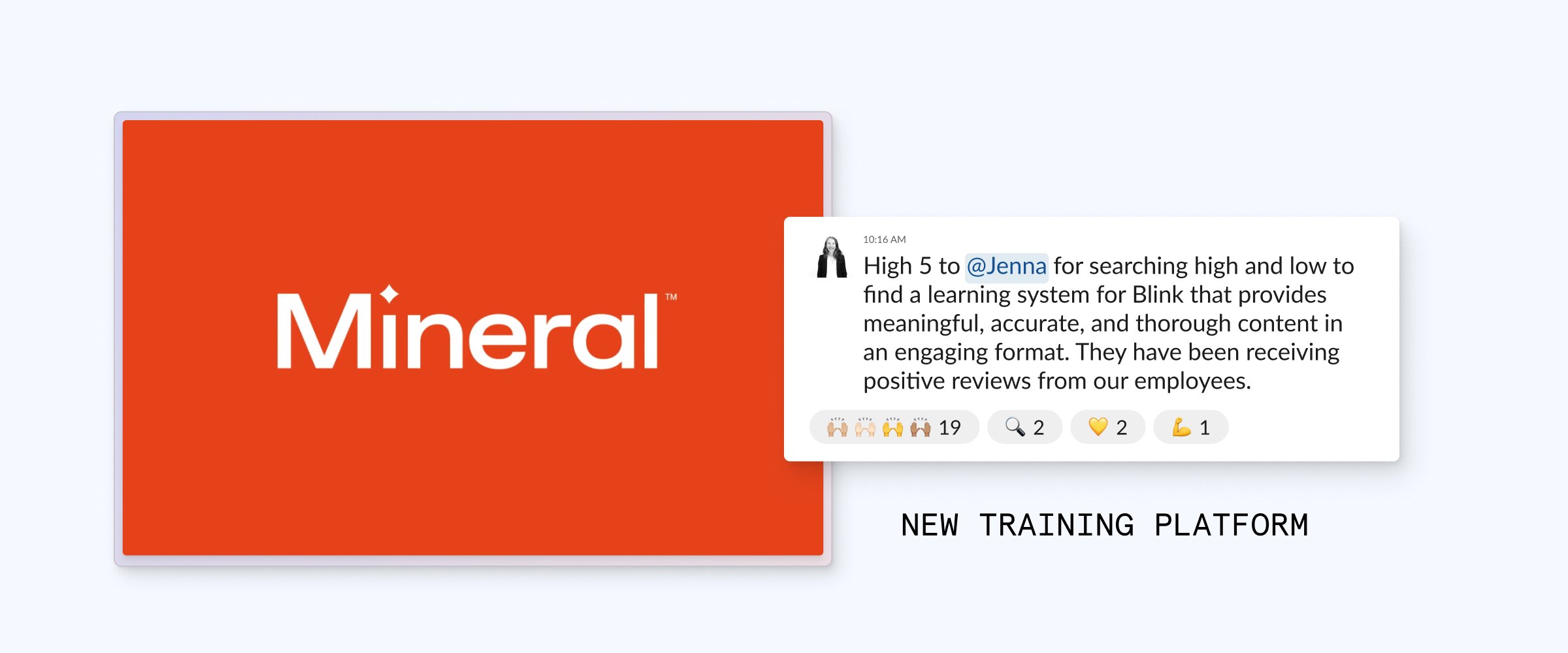
To have content that improves our internal understanding of harassment and other biases (unconscious bias and microaggressions, for example), we launched an initiative to find and implement an updated training platform. Our goal was to find a platform with engaging training that is relevant to our industry, leaving a lasting impression on our employees and managers. After several demos, we selected Mineral. We asked for feedback from managers and employees post-launch, and the new platform was well received.
Creating the first DEI page on our website
To cultivate a more diverse and equitable culture, we decided we needed to share our values and progress more intentionally with those outside of Blink.
In a collaborative effort between our marketing, sales, design, and research teams, we built a DEI page on the Blink website. By making our DEI efforts visible to potential partners and future employees, we aim to connect with those who share our passion for making a meaningful impact with their products and services.
As we head into 2024, we are gathering feedback from clients and leaders in the DEI space to improve the page, with more refinements coming soon.
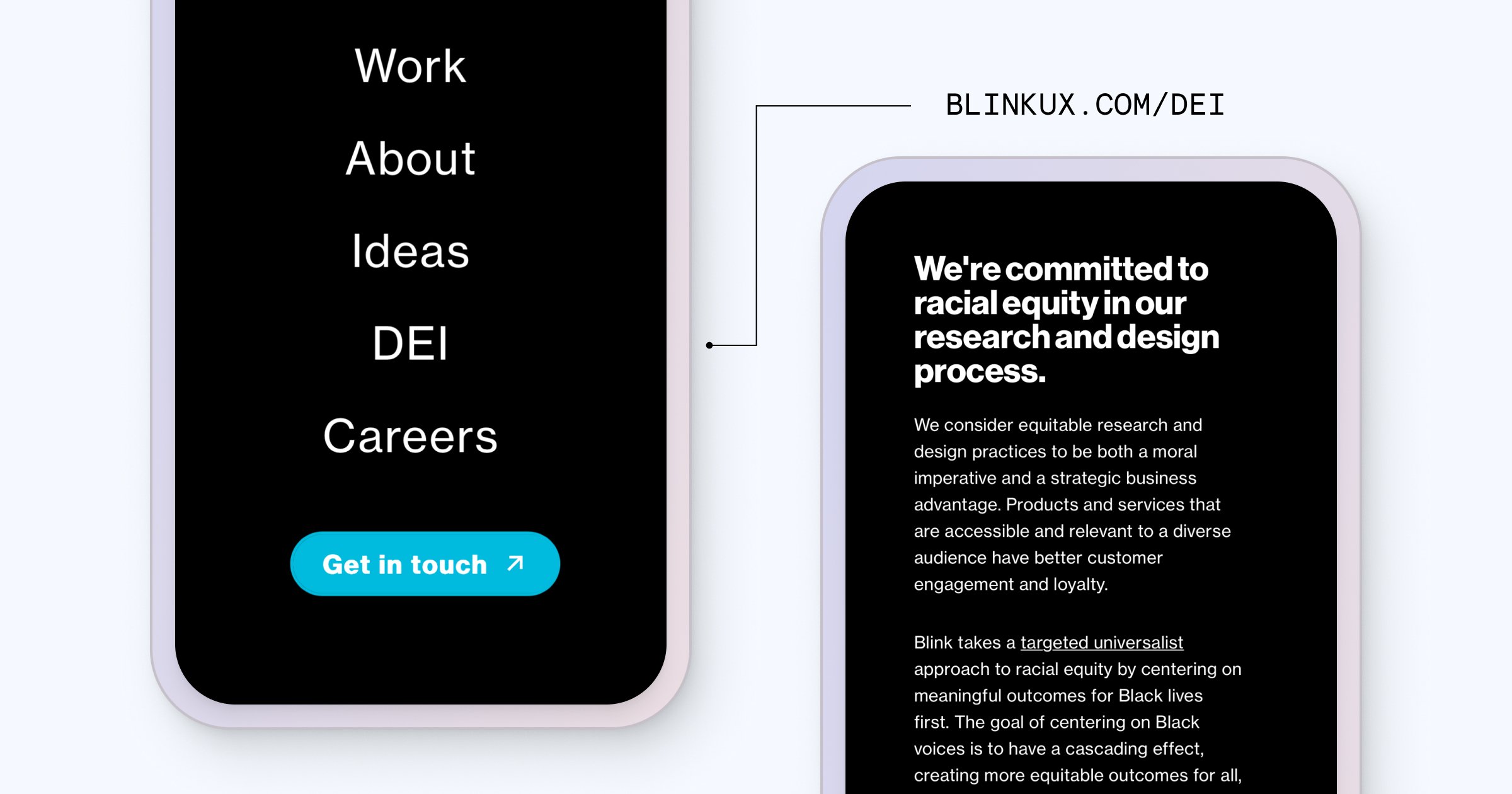
Beyond our core initiatives
In addition to these four areas of improvement, we continued to see progress throughout the organization last year. For example:
- We saw a 10% increase in BIPOC hires. In 2022, 48% of our hires were BIPOC. In 2023, we saw that number jump to 58.5%.
- We expanded Juneteenth programming to our company staff meeting, hosting an agenda that educates on the history and highlights inspiring Black leaders in culture, design, and research.
- This was an area where we initially missed the mark. Black employees felt that the educational content we shared throughout programming didn’t align with the celebratory nature of the holiday. Next year, we’ll modify our programming to better embody the spirit of the day.
- For Pride, we celebrated our LGBTQ+ colleagues while also sharing our support of the transgender community with a company-wide letter-writing event in connection with Point of Pride.
- We had a record number of 12 Blinkers take advantage of our recently updated paid family leave benefit, allowing Blink parents to take three months, fully paid, to bond with their family.
- We launched three additional internal newsletters on privilege, Juneteenth, and Pride.
- We opened our studios to several speakers and groups, including Timothy Bardlavens from Adobe, on making more equitable products, a Women in Tech Seattle meetup, and student tours with UCSD and San Diego City College.
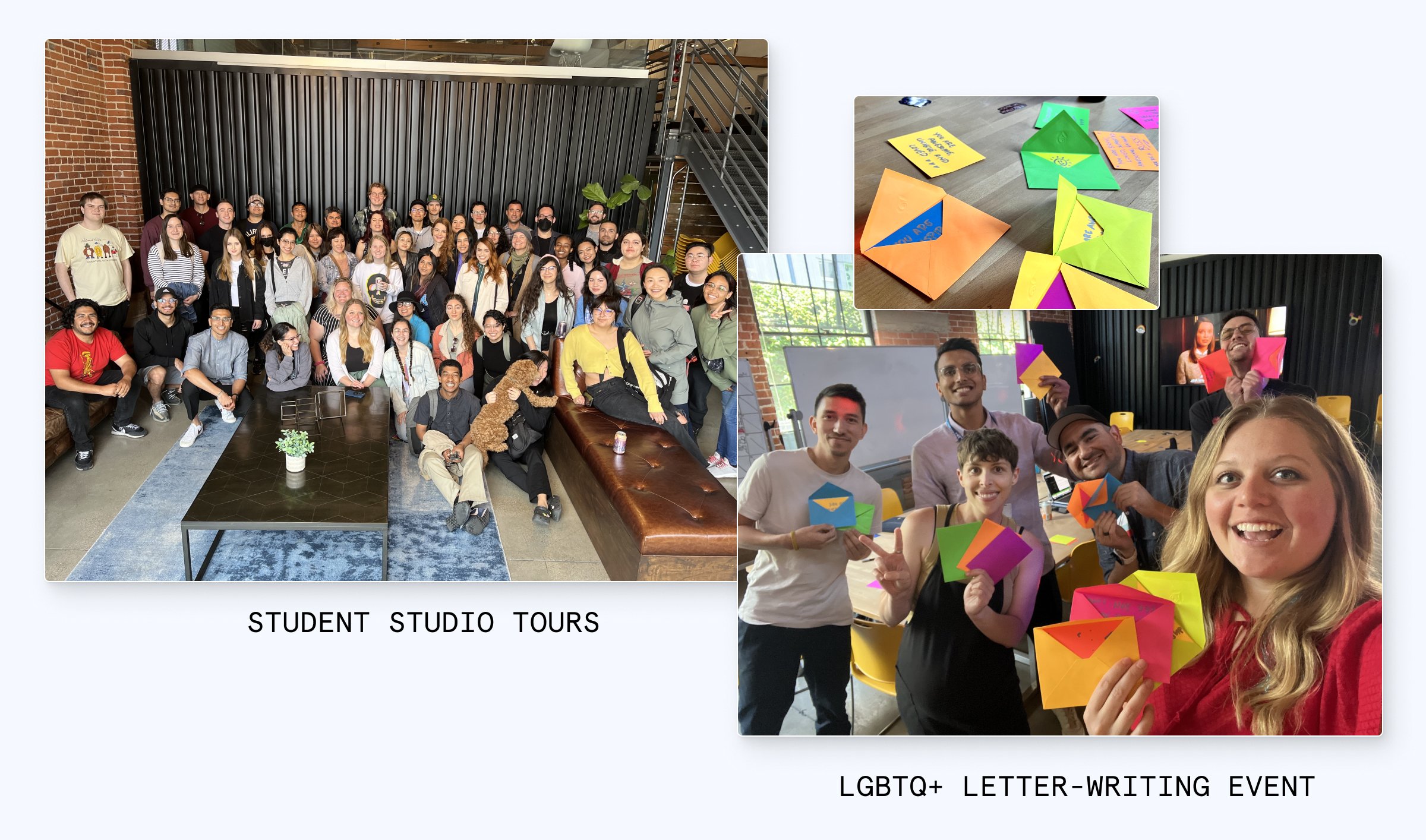
Continuing our DEI journey in 2024
As we look forward to 2024, we have identified the following initiatives to build upon our previous work:
- Develop ways to align with clients earlier in our process — focusing on the sales process and initial project kickoff. We feel the earlier we can begin the conversation around DEI and business strategy, the more impact we can have.
- Continue to work on our process for raises and promotions, focusing on identifying and removing any criteria that might negatively impact underrepresented employees.
- Identify additional metrics that we can use to measure the impact of our work in DEI.


